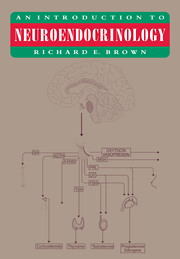Book contents
- Frontmatter
- Contents
- Preface
- Acknowledgements
- Illustration credits
- List of abbreviations
- 1 Classification of chemical messengers
- 2 The endocrine glands and their hormones
- 3 The pituitary gland and its hormones
- 4 The hypothalamic hormones
- 5 Neurotransmitters
- 6 Neurotransmitter control of hypothalamic, pituitary and other hormones
- 7 Regulation of hormone synthesis, storage, release, transport and deactivation
- 8 Regulation of hormone levels in the bloodstream
- 9 Steroid and thyroid hormone receptors
- 10 Receptors for peptide hormones, neuropeptides and neurotransmitters
- 11 Neuropeptides I: classification, synthesis and colocalization with classical neurotransmitters
- 12 Neuropeptides II: neuropeptide function
- 13 Cytokines and the interaction between the neuroendocrine and immune systems
- 14 Methods for the study of behavioral neuroendocrinology
- 15 An overview of behavioral neuroendocrinology: present, future and past
- Appendix Journals in endocrinology, neuroendocrinology, psychoneuroimmunology and behavioral endocrinology
- Index
14 - Methods for the study of behavioral neuroendocrinology
Published online by Cambridge University Press: 26 December 2009
- Frontmatter
- Contents
- Preface
- Acknowledgements
- Illustration credits
- List of abbreviations
- 1 Classification of chemical messengers
- 2 The endocrine glands and their hormones
- 3 The pituitary gland and its hormones
- 4 The hypothalamic hormones
- 5 Neurotransmitters
- 6 Neurotransmitter control of hypothalamic, pituitary and other hormones
- 7 Regulation of hormone synthesis, storage, release, transport and deactivation
- 8 Regulation of hormone levels in the bloodstream
- 9 Steroid and thyroid hormone receptors
- 10 Receptors for peptide hormones, neuropeptides and neurotransmitters
- 11 Neuropeptides I: classification, synthesis and colocalization with classical neurotransmitters
- 12 Neuropeptides II: neuropeptide function
- 13 Cytokines and the interaction between the neuroendocrine and immune systems
- 14 Methods for the study of behavioral neuroendocrinology
- 15 An overview of behavioral neuroendocrinology: present, future and past
- Appendix Journals in endocrinology, neuroendocrinology, psychoneuroimmunology and behavioral endocrinology
- Index
Summary
Behavioral neuroendocrinology involves the study of the interactive effects of the steroid and peptide hormones, neuropeptides, cytokines and neurotransmitters on behavior. Previous chapters have mentioned the role of the hypothalamic nucleii in behavior (Section 4.1), the behavioral effects of neurotransmitter agonists and antagonists (Section 5.8), the neuroendocrine correlates of psychiatric disorders (Section 6.8), the behavioral functions of the steroid hormones (Section 9.9), the cognitive and behavioral effects of neuropeptides (Section 12.5), and the effects of the cytokines on the brain and behavior (Section 13.5). This chapter discusses the behavioral methods used for the study of neuroendocrinology, the neural and genetic mechanisms mediating the effects of hormones on behavior, and some of the special problems involved in conducting behavioral neuroendocrinology research.
Neuroendocrine research involves a number of specific methods such as radioimmunoassays (Chapter 8), autoradiography (Chapter 9), receptor binding assays (Chapter 10) and immunohistochemical techniques (Chapters 11 and 13). The study of behavioral neuroendocrinology relies on specific behavioral methodologies or behavioral bioassays. As discussed in Section 8.1, a bioassay measures physiological changes in an animal or cell culture to determine the concentration or potency of a hormone in the circulation. Thus, the size of a cock's comb is a bioassay for testosterone level and the size and weight of the adrenal glands are bioassays for the level of ACTH. A behavioral bioassay measures behavioral changes to determine the concentration or potency of a hormone.
BEHAVIORAL BIOASSAYS
A behavioral bioassay requires precise qualitative (verbal) descriptions of the behaviors of interest and accurate quantitative (mathematical) measures of the latency, frequency and duration of these behaviors.
- Type
- Chapter
- Information
- An Introduction to Neuroendocrinology , pp. 346 - 394Publisher: Cambridge University PressPrint publication year: 1994



